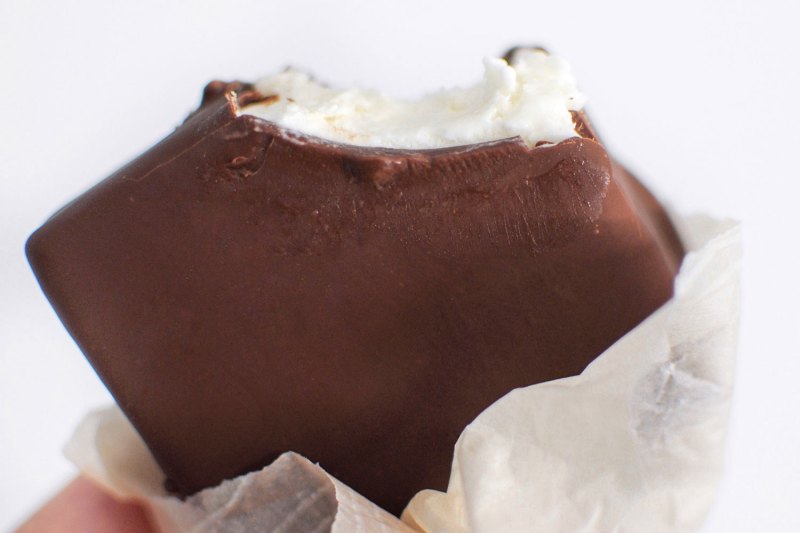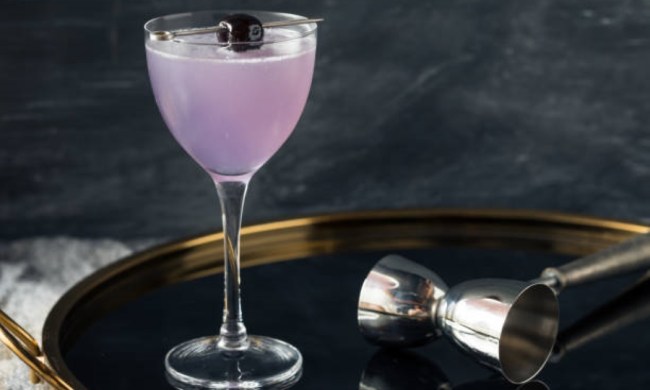When I think back on my favorite freezer treats from my childhood, one foil-wrapped package always occupies a special place in my memory: The incomparable Klondike Bar. This compact dessert — a square of vanilla ice cream enrobed in a chocolate shell and presented in a handheld foil fold — is a prime example of the value of simplicity; the Klondike Bar doesn’t include any bells and whistles because it doesn’t need them. It’s perfect just the way it is.
Since #quarantinelife has many home cooks seeking out ways to replicate nostalgic store-bought foods in a DIY manner, this seemed like the ideal time to ask professional pastry chefs and dessert professionals for their advice on crafting a homemade Klondike Bar. Luckily, our sources had plenty of wisdom to share, so you’ll be amply prepared for a “Klondike Bar” adventure of your very own.

If you’re using a paper pint of ice cream, then you can easily get a disk-shaped “Klondike Bar” with a sharp bread knife.
One of the toughest aspects of making your own Klondike bars involves maneuvering your ice cream into that signature square shape. However, if you’re not hung up on perfect angles and want a low-key strategy for getting dip-ready ice cream surfaces, try this idea from founder and cake maker Rosalin Siv of The Evercake in New York: “I take store-bought ice cream [pints] (like Haagen-Dazs) and flip them sideways. I then take my bread knife and slice off the bottom tapered side of the paper container.” She then removes the paper from the circular slice and inserts a popsicle stick to facilitate a clean and easy chocolate-dipping process.
A silicone mold can achieve a perfect square shape.
If you’re a Klondike purist who won’t settle for anything less than a square-shaped bar, then silicone molds are about to become your best friends. “Scoop your softened-but-not-melted ice cream into a silicone mold and not a metal mold. Using a silicone mold is great because you can easily pop the ice cream out of the mold when you’re ready to dip,” explains pastry chef Shawn Davis of Cotton Blues Kitchen & Marketplace in Hattiesburg, Mississippi. Use an ice cream scoop to accomplish this step.
Adding oil to your chocolate will give it a smoother texture.
Klondike Bars are rightly famous for their glossy chocolate exteriors, which provide a satisfying shatter with every bite. To replicate this effect in your home kitchen, you’ll want to keep your dipping chocolate smooth and lightweight, avoiding overly thick melts and unsightly clumps. The easiest way to get Klondike-appropriate chocolate? Add some oil.
“Once you melt the chocolate, you want to add a small amount of neutral oil, such as grapeseed or canola (usually about 1 oz. oil per 8 oz. of chocolate), and stir it into the chocolate. That will give your chocolate that frozen ‘magic shell’,” explains lead chef Tracy Wilk of the Institute of Culinary Education in New York City.
Neutral oils won’t affect the taste of your chocolate, but if you’d like to include an extra layer of flavor, follow the lead of Executive Bourbon Steward Kelly R. Ramsey of Art Eatables in Louisville, Kentucky (a bourbon-certified chocolatier) and “add coconut oil to your chocolate before coating the ice cream. The coconut oil will thin your chocolate out, so you have a [finer] layer of chocolate.”
High-quality chocolate will yield a tastier end product.
While there’s nothing stopping you from buying a bottle of pre-made Magic Shell and dunking your “Klondike Bars” in said elixir, taking the time to source and melt high-quality chocolate will pay off in the end. “Quality chocolate should be used in the coating for both flavor and consistency,” insists executive pastry chef Donald Wressell of Guittard Chocolate Company.
Tracy Wilk agrees with this estimation, adding that “homemade chocolate dip can be made with any kind of chocolate, so get creative! I like to use high-quality chocolate for this, such as a couverture (chocolate with a higher amount of cocoa butter), which will give you a nice, thin shell. If your chocolate doesn’t melt well (is chunky, thick, etc.) you won’t be able to achieve a thin shell, and it won’t melt easily when you go to bite into the bar.”
Focus on ice cream with a high fat content, and make sure that it’s thoroughly frozen before dipping.
Nothing will derail your homemade Klondike plans quicker than an overly soft and melty ice cream square, so it’s crucial to keep your bars as cold as possible prior to the dipping process. When it comes to specific ice cream selections, executive pastry chef Franck Iglesias of Foxwoods Resort Casino in Mashantucket, Connecticut assures us that “any of your favorite ice creams will work.” However, for best results, Iglesias advises “ice cream with a high fat content.” Premium ice creams from brands like Haagen-Dazs and Ben & Jerry’s tend to fall into this category.
Now, it’s time to try this homemade Klondike Bar recipe:
DIY Klondike Bar
(By Donald Wressell, executive pastry chef, Guittard Chocolate Company)
Wressell’s Klondike Bar recipe allows you to achieve perfectly frozen bars with smooth chocolate exteriors, and his formula proves easy to customize, depending on your desired quantities and your available equipment.
Ingredients:
- Premium ice cream, in a carton
- High-quality chocolate
- Oil (Wressell prefers coconut oil)
Method:
- Soften ice cream by placing the ice cream carton in an ice chest/cooler as close to the size of the carton as possible. Allow to stand for 30 minutes. The ice cream will “temper” uniformly throughout by using this method.
- Have a frozen silicone-lined rectangular pan ready. A half sheet pan works perfectly.
- Working quickly, press the contents of the ice cream carton into the pan. Place another silicone mat on top and press with a rolling pin to flatten uniformly, creating a flat sheet. Freeze the ice cream for several hours to set, and have an additional frozen silicone-lined pan ready.
- Remove ice cream sheet from the freezer and peel back the silicon mat from the top and replace it. Quickly loosen the sides of the ice cream from the pan and flip over. Now, peel the mat back, exposing the ice cream.
- Cut into desired-size squares with a metal spatula and move some onto the additional frozen silicone-lined pan, leaving space in between. Ideally, you should end up with two pans with evenly spaced ice cream squares. Freeze for an hour or until as frozen as can be.
- While your ice cream squares are ‘chilling,” prepare a coating by melting equal parts of coconut oil and high-quality chocolate. The finished temperature should be about 95 degrees Fahrenheit.
- Working quickly, dip the squares into the coating and place back onto a frozen silicone-lined tray. Freeze and enjoy!



